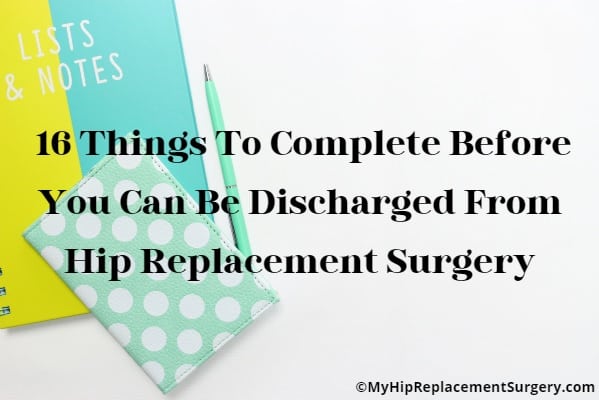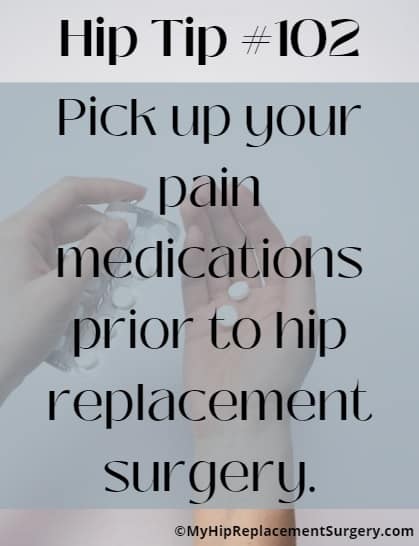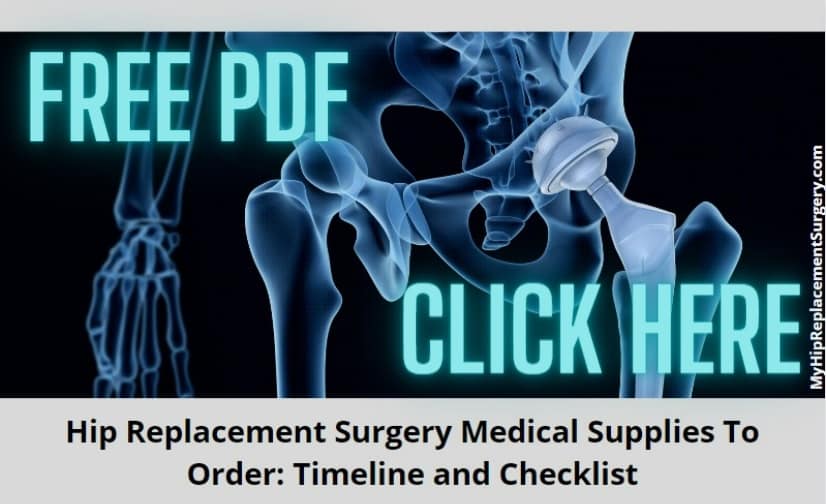Chapter 26 – The Days After Surgery – Checklist For Your Discharge From The Hospital (Putting Humpty-Dumpty Back Together)
Chapter 26 – The Days After Surgery – Checklist For Your Discharge From The Hospital (Putting Humpty-Dumpty Back Together)

- “You’re Healed!”
- Flowers (Make That M&M’s) For Algernon
- Short Term Recovery Goals List –
- Long Term Recovery Goals List
- Hip Tip – If It Hurts…
- Hip Tip – 16 Things To Complete Before You Can Be Discharged
- Dress For… Safety
- One Discharge That Is Nice
- Hip Tip – They Check In, But They Don’t Check Out
- Like Oprah, But Without The Car Keys
- Driving Miss Daisy
- 11 Steps On How To Safely Get Into Your Car For The Ride Home
- Sore Hip Replaced With… Sore Hip
- Hip Tip – Narcotics Have To Be Picked Up In Person
- Warfarin
- Hip Tip – Don’t Eat Your Greens
- I (Won’t) Drink To That

Checklist For Your Discharge From The Hospital
“You’re Healed!” – The first thing I realized, even over my surgical pain, is that somehow Steve Martin as the charlatan preacher in the Leap of Faith movie had come over and lowered his head, closed his eyes, paused as he took a deep breath while placing his fervent hands upon my hips, then rapidly pulled them away and loudly proclaimed to me and the world, “You’re healed!” To the utter surprise of Steve, and me, I was. Who knew it would be that easy?
Short-Term Recovery Goals List – Short-term recovery involves getting off major pain killers and having a full night’s sleep without pills. Once you no longer require walking aids, you can walk around the house without pain, and you can walk two blocks in the neighborhood, you have reached the first marker sign of short-term recovery.
The average short-term recovery time for a total hip replacement is four to six weeks. The first two to four weeks are the hardest and you should have help at home during this period.
If you live alone and find it difficult to care for yourself, you might examine staying at an outpatient rehabilitation facility. Check with your insurance carrier as to what might, or might not, be covered.
Long-Term Recovery Goals List – Long-term recovery takes, well, longer. When you can return to work and resume typical activities of daily living, you are on your way to achieving the full-term of recovery. A simple indicator of long term recovery is when you finally feel ‘normal’ again. The average long term recovery for total hip replacement patients is approximately six to twelve months.
Hip Tip – If It Hurts… – Don’t try and over-exert or push yourself too much. Pain is a great regulator and will let you know what you can and cannot do.

Hip Tip – 16 Things To Complete Before You Can Be Discharged: If you want to gain discharge approval, you will need to complete and/or understand the following:
- Recognize the signs of surgical complications.
- Understand all the medications you are taking, their purpose, and possible side effects.
- Gain approval from both your physical and occupational therapists that you can safely complete your necessary daily activities.
- Understand and master your safe hip precautions.
- Demonstrate you can get in and out of bed autonomously.
- Be able to safely use your walking device on your own for at least 50 feet.
- Be able to bathe and dress yourself using special tools without assistance.
- Use the toilet or commode without assistance.
- Be able to keep solid food down.
- Have normal vital signs.
- Demonstrate you can stand and have balance for 10 minutes at a counter or sink.
- Be able to safely access your bathtub or shower.
- Be able to safely climb up and down 12 stairs.
- Learn how to get into and out of a car with help.
- Understand your home exercise program as instructed by your therapists.
- Have your incision examined and verified that it is without infection.
- Weight: 19 lbs.
- Weight Limit: 350 lbs.
- Height-Adjustable Grips: 31 – 35 inches
- Compact: Folds for easy storage
- Lightweight: 0.43 lbs.
- Floor-Safe: Won’t scratch tiles, wood floors, or carpet
- Easy-to-Use: Just pop the gliders onto your walker!
- Universal Fit: Fits almost all walkers with 1-inch diameter
- Easy to Use: Makes walking with a walker much easier
- 2-Pack: Comes with two glide covers
Dress For Safety – Your occupational therapist will instruct you how to use the adaptive equipment tools when dressing. Here are some safe guidelines your therapist will share with you:
- Use your dressing stick, sock aid, and long-handled shoe horn to avoid bending forward when putting on socks and shoes.
- Do not cross your legs when putting on pants, socks and shoes.
- Use your grabber to help put your pants on. Put your operated leg into the pant leg first. Then, put the non-operated leg into the other pant leg using a reacher or dressing stick.
- To remove your pants, first have a reacher or dressing stick to remove the non-operated leg from the pant leg. Lastly, remove the operated leg from the other pant leg.
- Nobody likes to fall to the ground so keep your back touching the back of the chair.
- Use elastic shoelaces or slip-on shoes as needed.
How To Check Out Of The Hospital
One Discharge That Is Nice – Most people will spend two to five days in the hospital recovering from hip replacement surgery before they are discharged. Some individuals may require additional recovery time in a rehab facility, where the average stay is seven days. The two major factors determining your need for a rehab facility involve your medical condition and possibly the comprehensiveness of your insurance plan.
Hip Tip – They Check In, But They Don’t Check Out: In my case, my dignity was the only thing that was left at the hospital. Make sure to check all the drawers and closets for any personal items you brought with you.
If you planned ahead, you will have brought minimal items from home. Pay attention to your electronic items like cell phones and tablets. The most common items left behind are power cables for your electronics. According to my floor nurse, glasses are a close second.
Like Oprah, But Without The Car Keys – The wheelchair technician came to navigate me down to the main hospital floor and into my car. I sat into the one-size fits all chair (it doesn’t) and thought that maybe if, after spending $60,000, there might be a surprise under my wheelchair seat. There wasn’t, not even a bottle of laxative. So much for gracious hosts.
Transportation Home
Driving Miss Daisy – Make sure your chauffeur is at the hospital at the time of your discharge. The larger the car, the more comfortable you will be on the ride home. Your therapist will advise you on how to safely get in and out of your car.
11 Steps On How To Safely Get Into Your Car For The Ride Home – Here is a checklist for you:
- Slide the passenger seat as far back as it will allow.
- Recline the seat back as far as possible, almost laying down if possible.
- Slowly back up to the car seat using while using your walker in front of you.
- Once you are close enough, sit on your car seat.
- Next, swing your legs into the car. You will probably need to use your leg strap on your operated leg. Lean back so that you avoid bending your hip more than 90 degrees.
- If you have a long ride home, you may need to make frequent stops so you can walk around. It will be hard to get in and out of the car over and over.
- When you are ready to get out of the car, make sure the seat is slid as far back as it will go.
- Make sure that you recline the back of the seat as far as it will go.
- Carefully lift your legs out. You will probably need to use your leg strap on your operated leg again.
- Lean back if you need to avoid bending at the hip more than 90 degrees.
- Your caregiver should have placed the walker up in front for support.
Pain Medications
“Pain pain go away. Come again another day.”
Adapted nursery rhyme song
Sore Hip Replaced With… Sore Hip – The good news was that I could tell right away that the arthritic pain I was experiencing was gone. The surgery had resolved the pain. The bad news was that the pain from the surgery had, temporarily, replaced it. I had picked up all my pain medications before surgery and had an inventory of pills to stave off the pain (or sell to try and offset the cost of my deductible).

Hip Tip – Narcotics Have To Be Picked Up In Person: If you end up in substantial post-surgical pain, you may not have received enough narcotic pills to help you through your recovery. Try and assess the pain you have before you leave the hospital and communicate that to the medical staff.
If they deem your pain excessive, it will be possible to receive additional narcotics before you go home. If you get home then determine you are in pain, your loved one most likely will have to travel to a specific pharmacy to pick up the narcotic pain pills in person.
Other Meds
Warfarin – I vaguely recall from one of my college classes that warfarin (Coumadin) was used to kill rats. The rats would eat baited food and then internally bleed to death. When I saw my prescription, I wondered if my mother-in-law had shared her opinion that I was a ‘dirty rat’ with my orthopod.
Warfarin is used after surgery to prevent blood from clotting. I was advised that since I was taking Warfarin, I shouldn’t be taking any NSAIDs (aspirin, ibuprofen, Advil, Motrin, Aleve, Naprosyn) until after completed the warfarin treatment.
Hip Tip – Don’t Eat Your Greens: Vitamin K can lessen Warfarin’s effectiveness so it’s important to be consistent in how much vitamin K you consume daily. Foods with vitamin K include: kale, spinach, Brussels sprouts, parsley, collard greens, mustard greens and chard. Certain drinks can increase the effect of Warfarin, leading to internal bleeding problems. These drinks include: green tea, cranberry juice, and alcohol. After you have completed your Warfarin regimen, and with the permission of your pharmacist, you can return to leafy green plants.
I (Won’t) Drink To That – If you are on warfarin, you should avoid alcohol. After you complete your Warfarin regimen, you should be able to drink in moderation. Of course, narcotics and some other medications may prohibit you from drinking. You don’t want to be staggering around with a recently repaired hip.
Alrighty… that concludes Chapter 26.






